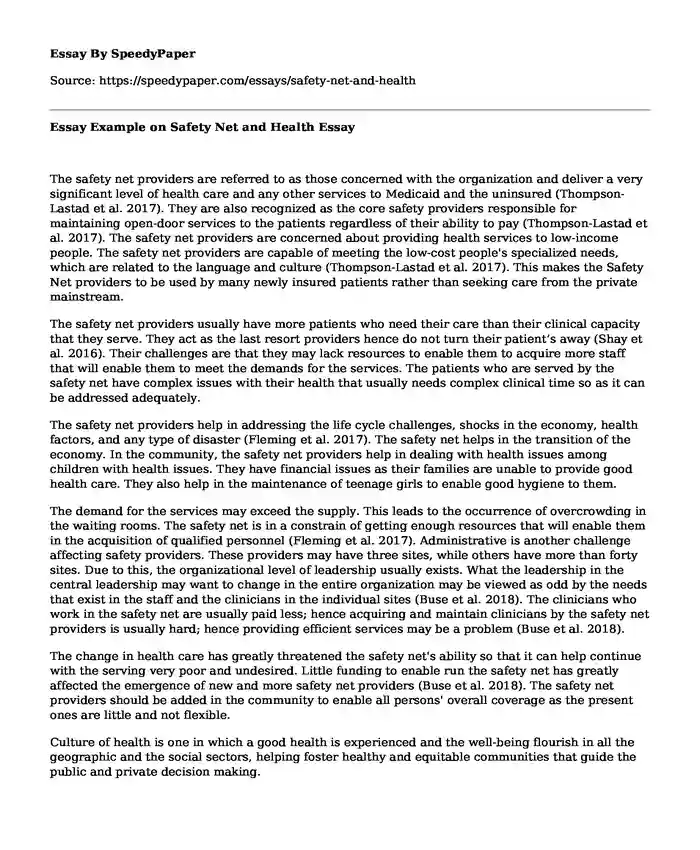
| Type of paper: | Essay |
| Categories: | Problem solving Healthcare policy Social issue |
| Pages: | 3 |
| Wordcount: | 718 words |
The safety net providers are referred to as those concerned with the organization and deliver a very significant level of health care and any other services to Medicaid and the uninsured (Thompson-Lastad et al. 2017). They are also recognized as the core safety providers responsible for maintaining open-door services to the patients regardless of their ability to pay (Thompson-Lastad et al. 2017). The safety net providers are concerned about providing health services to low-income people. The safety net providers are capable of meeting the low-cost people's specialized needs, which are related to the language and culture (Thompson-Lastad et al. 2017). This makes the Safety Net providers to be used by many newly insured patients rather than seeking care from the private mainstream.
The safety net providers usually have more patients who need their care than their clinical capacity that they serve. They act as the last resort providers hence do not turn their patient’s away (Shay et al. 2016). Their challenges are that they may lack resources to enable them to acquire more staff that will enable them to meet the demands for the services. The patients who are served by the safety net have complex issues with their health that usually needs complex clinical time so as it can be addressed adequately.
The safety net providers help in addressing the life cycle challenges, shocks in the economy, health factors, and any type of disaster (Fleming et al. 2017). The safety net helps in the transition of the economy. In the community, the safety net providers help in dealing with health issues among children with health issues. They have financial issues as their families are unable to provide good health care. They also help in the maintenance of teenage girls to enable good hygiene to them.
The demand for the services may exceed the supply. This leads to the occurrence of overcrowding in the waiting rooms. The safety net is in a constrain of getting enough resources that will enable them in the acquisition of qualified personnel (Fleming et al. 2017). Administrative is another challenge affecting safety providers. These providers may have three sites, while others have more than forty sites. Due to this, the organizational level of leadership usually exists. What the leadership in the central leadership may want to change in the entire organization may be viewed as odd by the needs that exist in the staff and the clinicians in the individual sites (Buse et al. 2018). The clinicians who work in the safety net are usually paid less; hence acquiring and maintain clinicians by the safety net providers is usually hard; hence providing efficient services may be a problem (Buse et al. 2018).
The change in health care has greatly threatened the safety net's ability so that it can help continue with the serving very poor and undesired. Little funding to enable run the safety net has greatly affected the emergence of new and more safety net providers (Buse et al. 2018). The safety net providers should be added in the community to enable all persons' overall coverage as the present ones are little and not flexible.
Culture of health is one in which a good health is experienced and the well-being flourish in all the geographic and the social sectors, helping foster healthy and equitable communities that guide the public and private decision making.
References
Thompson-Lastad, A., Yen, I. H., Fleming, M. D., Van Natta, M., Rubin, S., Shim, J. K., & Burke, N. J. (2017). Defining trauma in complex care management: safety-net providers' perspectives on structural vulnerability and time. Social Science & Medicine, 186, 104-112. https://www.ncbi.nlm.nih.gov/books/NBK224524/
Shay, L. A., Street Jr, R. L., Baldwin, A. S., Marks, E. G., Lee, S. C., Higashi, R. T., ... & Tiro, J. A. (2016). Characterizing safety-net providers’ HPV vaccine recommendations to undecided parents: a pilot study. Patient education and counseling, 99(9), 1452-1460. https://www.healthaffairs.org/doi/full/10.1377/hlthaff.15.2.33
Fleming, M. D., Shim, J. K., Yen, I. H., Thompson-Lastad, A., Rubin, S., Van Natta, M., & Burke, N. J. (2017). Patient engagement at the margins: health care providers' assessments of engagement and the structural determinants of health in the safety-net. Social Science & Medicine, 183, 11-18 https://www.ncbi.nlm.nih.gov/books/NBK224524/
Buse, C., Martin, D., & Nettleton, S. (2018). Conceptualizing 'materialities of care': making visible mundane material culture in health and social care contexts. Sociology of Health & Illness, 40(2), 243-255. https://www.researchgate.net/publication/269175928_Culture_and_health
Cite this page
Essay Example on Safety Net and Health. (2023, Dec 11). Retrieved from https://speedypaper.com/essays/safety-net-and-health
Request Removal
If you are the original author of this essay and no longer wish to have it published on the SpeedyPaper website, please click below to request its removal:
- Essay Sample: US Music Diplomacy in the USSR
- Essay Sample on Interventions on Reducing HCV Prevalence in the Incarcerated Population
- Film Review: My Sister's Keeper - Free Essay
- Free Essay: American Dream and the Immigration
- Essay Sample on Uber Kalanick Temporary Leave of Absence
- Essay Sample on Virtual Lab Experiment
- Free Paper Sample on Sexual Orientation
Popular categories




